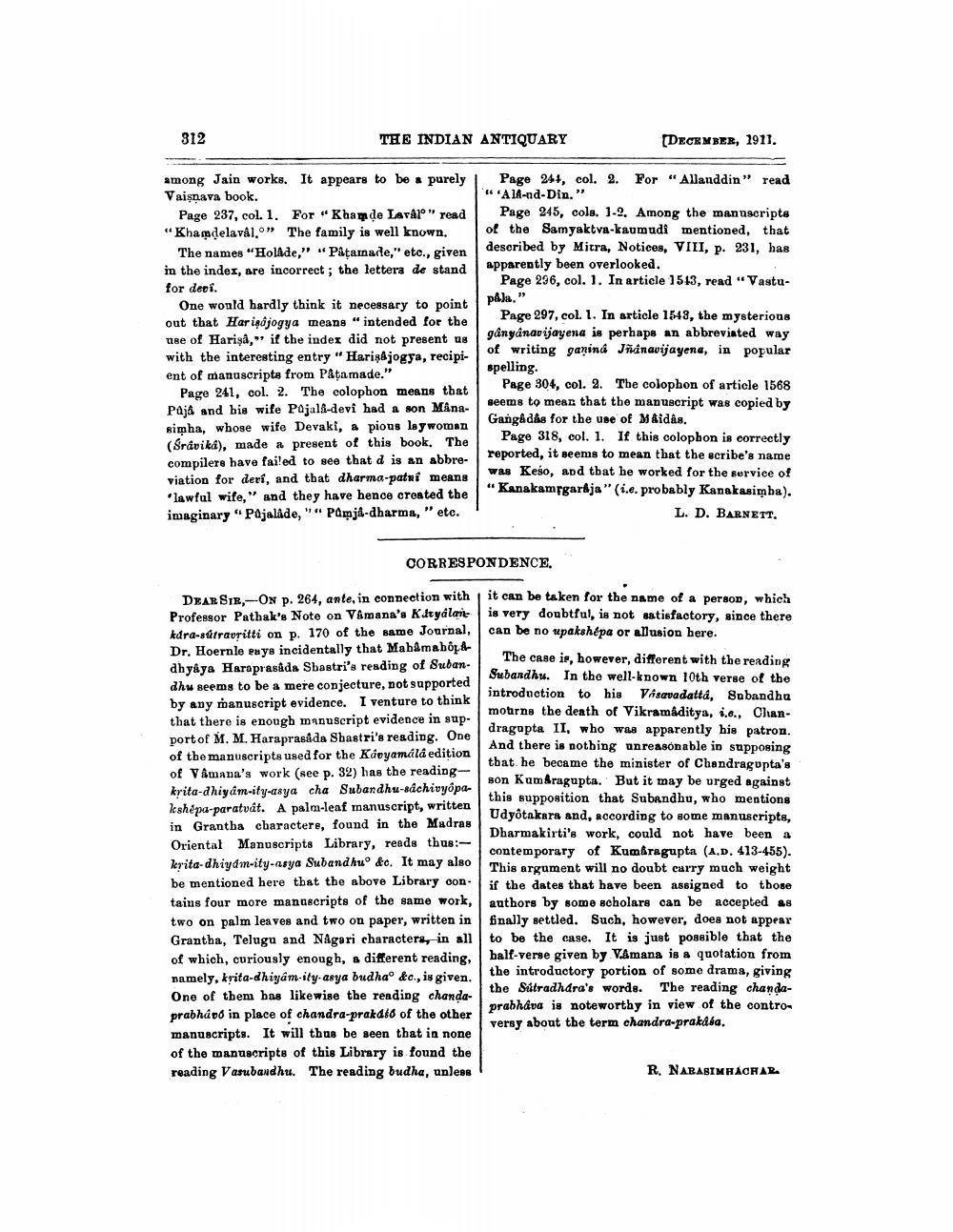________________
312
THE INDIAN ANTIQUARY
(DECEMBER, 1911.
among Jain works. It appears to be purely | Page 244, col. 2. For “Allanddin” read Vaisnava book.
"A1A-ud-Din.” Page 237, col. 1. For "Khande Lavá1©" read P age 245, cols. 1-2. Among the manuscripts "Khamdelavá1.0" The family is well known, of the Samyaktva-kaumudi mentioned, that
The names "Holde," " Patamadle," etc., given described by Mitra, Notices, VIII, p. 231, in the index, are incorrect; the lettera de stand apparently been overlooked. for deri.
Page 236, col. 1. In article 1513, read "Vastu
p&la.” One would hardly think it necessary to point pala." out that Har inájogya means "intended for the
Page 297, col. 1. In article 1543, the mysterious use of Hariş, if the index did not present us
gånyánavijayena is perhaps an abbreviated way with the interesting entry " Harişkjogya, recipi
of writing ganina Jñinavijayene, in popular ent of manuscripts from Pața made."
spelling. Page 241, col. 2. The colophon means that
Page 304, col. 2. The colophon of article 1568
seems to mean that the manuscript was copied by Paja and his wife Pajal-devi had a son Mânasimha, whose wife Devaki, a pious lay woman
Gangadás for the use of M&idas. (Sráviká), made a present of this book. The
Page 318, col. 1. If this colophon is correctly
reported, it seems to mean that the scribe's name compilere have failed to see that d is an abbreviation for ders, and that dharma-patrí means
was Keso, and that he worked for the service of
"Kanakamfgarkja" (i.e. probably Kanakasimba). lawful wife," and they have bence created the imaginary "Pajalade," " Pamj4-dharma," etc.
L. D. BARNETT.
CORRESPONDENCE.
DEAR SIE.ON p. 264, ante, in connection with Professor Pathak's Note on Vamana's Katyalant kdra-sútravritti on p. 170 of the same Journal, Dr. Hoernle pays incidentally that Mabamabot dhyâya Haraprasada Shastri's reading of Subandhu seems to be a mere conjecture, not supported by any manuscript evidence. I venture to think that there is enough manuscript evidence in support of M. M. Haraprasada Shastri's reading. One of the manuscripts used for the Kaoyamala edition of Vamana's work (see p. 32) has the readingkrita-dhiyam-ity-asya cha Subardhu-edchivyopaleshepa paratvat. A palm-leaf manuscript, written in Grantha characters, found in the Madras Oriental Manuscripts Library, reads thus:-- kerita dhiyam-ity-usya Subandhuo &c. It may also be mentioned here that the above Library oon. tains four more manuscripts of the same work, two on palm leaves and two on paper, written in Grantha, Telugu and Nagari characters, in all of which, curiously enough, a different reading, namely, krita-dhiyam-ity.asya budhao do, is given. One of them bas likewise the reading chandaprabhápå in place of chandra-prakdio of the other manuscripts. It will thus be seen that in none of the manuscripts of this Library is found the reading Vasubandhu. The reading budha, unless
it can be taken for the name of a person, which is very doubtful, is not satisfactory, since there can be no upakshépa or allusion here.
The case is, however, different with the reading Subandh. In the well-known 10th verse of the introduction to his Vasavadattd, Subandhu mourns the death of Vikramaditya, i.e., Chandragopta II, who was apparently his patron. And there is nothing unreasonable in supposing that he became the minister of Chandragupta's son Kum&ragupta. But it may be urged against this supposition that Subandhu, who mentions Udyðtakara and, according to some manuscripts, Dharmakirti's work, could not have been a contemporary of Kumiragupta (A.D. 413-455). This argument will no doubt carry much weight if the dates that have been assigned to those authors by some scholars can be accepted as finally settled. Such, however, does not appear to be the case. It is just possible that the ball-verse given by Vamana is a quotation from the introductory portion of some drama, giving the Satradhdra's words. The reading chandaprabhava is noteworthy in view of the contro versy about the term chandra-prakába.
R. NARASIMHACRAR




